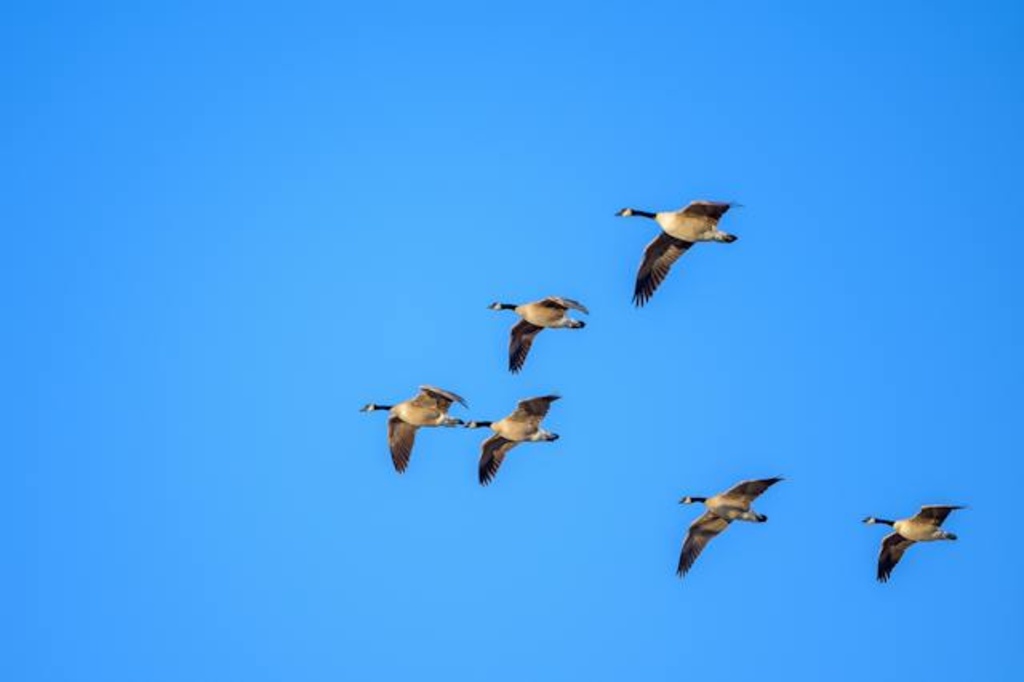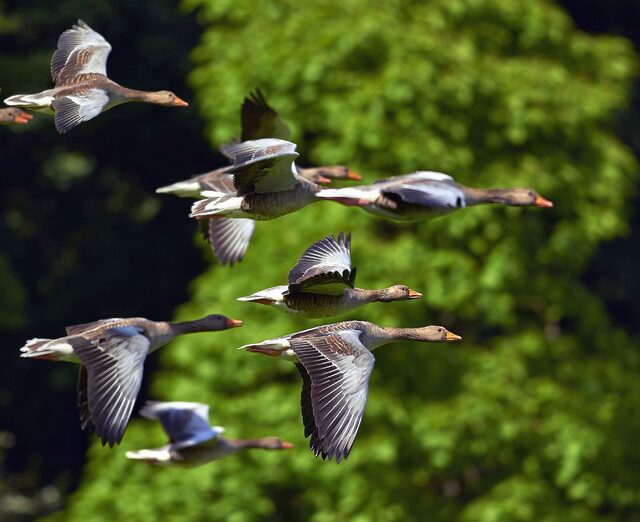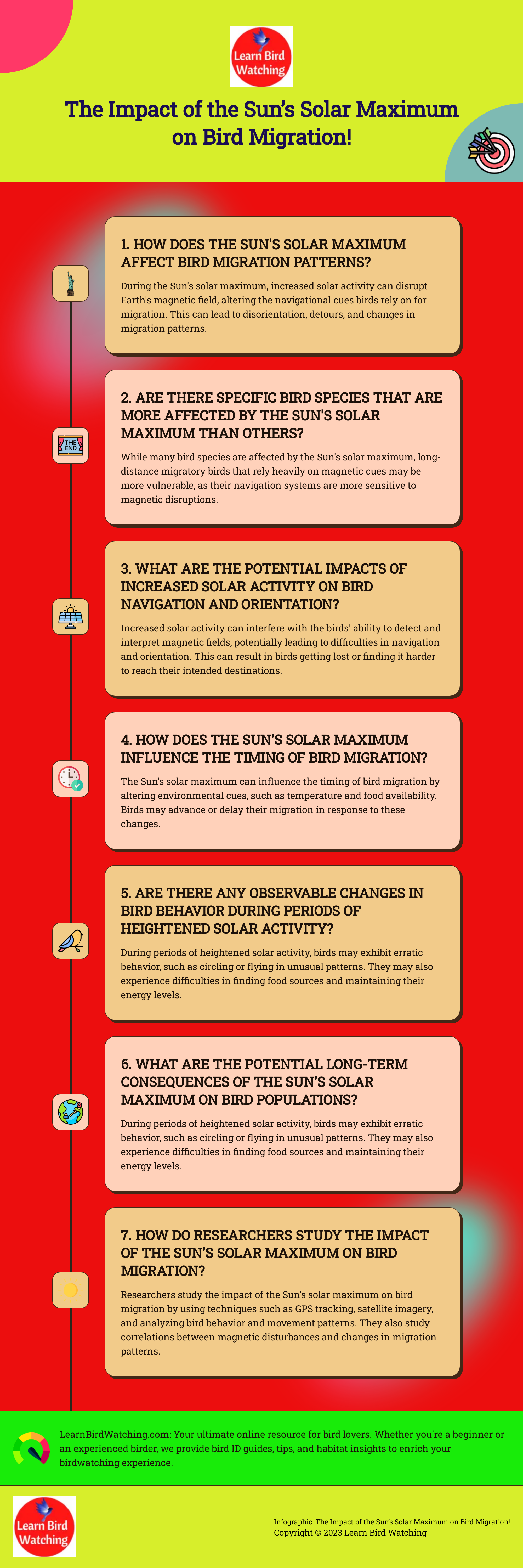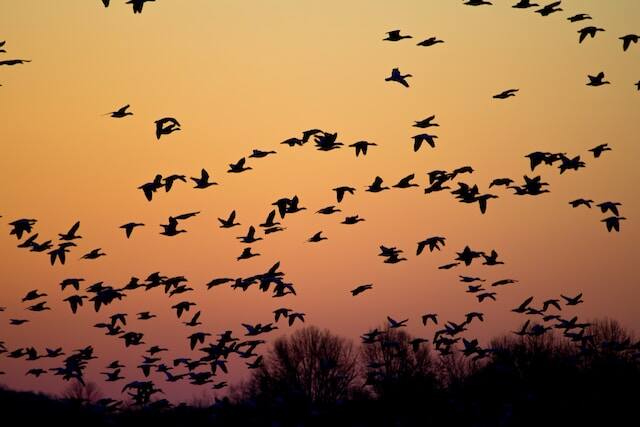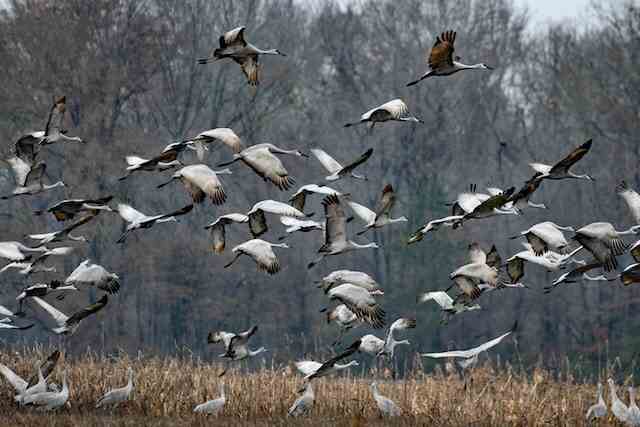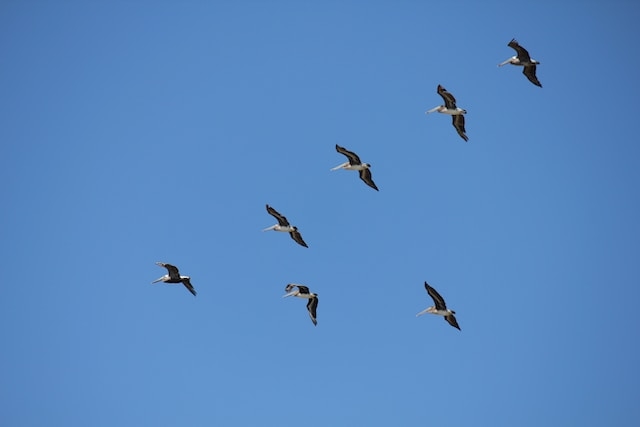In this post I’am excited to share with you the fascinating topic of how birds navigate during the Sun’s Solar Maximum event, expected to occur in 2024. The Solar Maximum is a period of increased solar activity, resulting in solar flares and storms, that may impact various systems on Earth, including migratory birds.
In this article, we will explore the impact of the Sun’s Solar Maximum on bird migration patterns, as well as the strategies migratory birds employ to navigate through changing solar conditions.
Table of Contents
- 1 Key Takeaways:
- 2 Understanding Solar Maximum and Bird Migration
- 3 The Sun’s Impact on Bird Migration
- 4 Bird Migration Patterns and Solar Maximum
- 5 Navigation Strategies of Migratory Birds
- 6 Impacts of Solar Maximum on Bird Behavior
- 7 Bird Conservation during Solar Maximum
- 8 Scientific Research and Observations
- 9 Future Perspectives and Predictions
- 10 Conclusion
- 11 FAQs
- 11.1 How does the Sun’s Solar Maximum impact bird migration?
- 11.2 What is Solar Maximum?
- 11.3 How do birds navigate during the Solar Maximum?
- 11.4 What is the impact of solar flares and solar storms on bird migration?
- 11.5 How does solar variability affect bird migration?
- 11.6 Do all bird species react the same way to Solar Maximum events?
- 11.7 How do migratory birds use environmental factors for navigation during Solar Maximum?
- 11.8 Are there any observed changes in bird behavior during Solar Maximum?
- 11.9 What can be done to conserve migratory birds during Solar Maximum events?
- 11.10 What scientific research has been conducted on bird migration during Solar Maximum?
- 11.11 What are the future predictions for bird migration during Solar Maximum?
- 12 Author
Key Takeaways:
- The Sun’s Solar Maximum may impact bird migration patterns.
- Migratory birds employ various navigation strategies during Solar Maximum events.
- Solar radiation and variability can affect bird behavior and navigation abilities.
- Conservation efforts can help mitigate the potential risks and challenges faced by migratory birds during Solar Maximum.
- Ongoing scientific research can provide insights into future bird migration patterns during Solar Maximum events.
Understanding Solar Maximum and Bird Migration
In this section, I will explain the concept of Solar Maximum and its significance for bird migration. Solar Maximum refers to a period of heightened solar activity, characterized by increased radiation, flares, and storms. These events can have profound impacts on the behavior and navigation abilities of migratory birds.
Solar Activity and Bird Migration
The Sun’s activity, including its radiation and magnetic fields, can influence bird migration patterns. Studies have shown that birds can detect changes in magnetic fields and use them as a navigational aid. During Solar Maximum, the Earth’s magnetic field can be disrupted, making navigation more difficult for birds. This can lead to changes in migration routes and timing.
Solar Flares and Bird Migration
Solar flares are bursts of energy released by the Sun that can have a range of effects on the Earth’s atmosphere and magnetic fields. They can cause disruptions in radio and satellite communications and create colorful auroras in the sky. During Solar Maximum, solar flares can also impact bird migration patterns. Research has shown that some bird species may be able to sense the electromagnetic disturbances caused by solar flares and adjust their behavior accordingly.
Solar Storms and Bird Migration
Solar storms are large eruptions of plasma and magnetic fields from the Sun’s corona. They can cause significant disruptions to the Earth’s magnetic field and ionosphere. During Solar Maximum, solar storms can be more frequent and intense, which can potentially impact bird migration. Although research on the effects of solar storms on bird migration is limited, some studies have suggested that solar storms may cause birds to become disoriented or even strand them in unfamiliar locations.
“During Solar Maximum, the Earth’s magnetic field can be disrupted, making navigation more difficult for birds.”
The table below summarizes the key effects of solar activity, solar flares, and solar storms on bird migration:
| Solar Activity | Solar Flares | Solar Storms | |
|---|---|---|---|
| Effects | Disrupts Earth’s magnetic field | Creates electromagnetic disturbances | Disrupts Earth’s magnetic field and ionosphere |
| Impact on Birds | Can make navigation more difficult | May be able to sense disturbances and adjust behavior | May cause disorientation or stranding in unfamiliar locations |
Understanding the effects of Solar Maximum on bird migration is essential for mitigating potential risks and protecting these vital species. In the next section, I will explore the specific ways in which the Sun’s activities affect avian migration patterns.
The Sun’s Impact on Bird Migration
The Sun’s activities have a significant impact on bird migration patterns. Solar radiation and solar variability affect the behavior and navigation abilities of migratory birds during their journey.
Solar radiation refers to the emission of energy from the Sun, which includes ultraviolet (UV) radiation and other forms of electromagnetic radiation. UV radiation can have both positive and negative effects on birds and their migration. On one hand, UV radiation can be used by birds for navigation and orientation. However, prolonged exposure to UV radiation can also have harmful effects on birds, such as damaging their eyes and feathers.
Solar variability refers to the changes in the amount of energy emitted by the Sun over time. This variability affects the Earth’s magnetic field and atmospheric conditions, which in turn affects the behavior of migratory birds. For example, changes in the Earth’s magnetic field can disrupt a bird’s navigation system and cause it to become disoriented.
“The Sun’s activities have a significant impact on bird migration patterns.”
Research has shown that migratory birds are sensitive to changes in solar activity. For example, a study conducted by researchers at the University of Oldenburg in Germany found that during periods of high solar activity, migratory birds increased their flight altitude to avoid the effects of increased solar radiation.
Another study conducted by researchers at the University of Groningen in the Netherlands found that European robins alter their migratory routes and timing in response to changes in the Earth’s magnetic field caused by solar storms.
| Effect of Solar Activity on Birds | Examples |
|---|---|
| Solar radiation | Birds use UV radiation for navigation and orientation, but prolonged exposure can have harmful effects on their eyes and feathers. |
| Solar variability | Changes in the Earth’s magnetic field caused by solar storms can disrupt bird navigation and cause them to become disoriented. |
In conclusion, the Sun’s activities have a profound impact on bird migration. Solar radiation and solar variability affect migratory birds’ behavior and navigation abilities, which can lead to changes in their migration routes and timing. Ongoing research and conservation efforts are crucial to understanding and mitigating the impact of solar activity on migratory birds.
Bird Migration Patterns and Solar Maximum
As we have previously discussed, migratory birds are highly adaptable creatures. They are known to alter their migration routes and timing in response to environmental cues, such as temperature changes and wind patterns.
During Solar Maximum events, birds make similar adjustments to their migration patterns. These events can significantly affect the behavior of birds and alter the timing and routes of their journeys.
Studies have shown that during Solar Maximum, some bird species begin their migration earlier or later than usual. For example, a study on European robins found that in years with high solar activity, the birds tended to migrate earlier than in years with low solar activity.
This adaptation is likely due to the impact of increased solar radiation on the Earth’s magnetic field, which birds use to navigate. During Solar Maximum, the Earth’s magnetic field can become distorted, affecting birds’ ability to navigate accurately. By migrating earlier or later, birds can avoid these magnetic distortions and maintain their sense of direction.
Comparing Bird Migration Patterns During Solar Maximum and Solar Minimum
To gain a better understanding of the impact of Solar Maximum on bird migration, let us compare the migration patterns of birds during Solar Maximum and Solar Minimum events.
| Solar Maximum | Solar Minimum | |
|---|---|---|
| Bird species | European robins | White storks |
| Migration adjustment | Migration begins earlier | Migration begins later |
| Reason for adjustment | Avoiding magnetic distortions caused by increased solar radiation | Responding to changes in temperature and wind patterns |
As illustrated in the table above, different bird species respond to Solar Maximum events in different ways. European robins adjust their migration by starting earlier, while white storks adjust by starting later. These adaptations allow birds to navigate through the changing solar conditions and complete their migrations successfully.
Understanding the impact of Solar Maximum on bird migration patterns is essential for conservation efforts. By recognizing the adjustments made by migratory birds during Solar Maximum events, we can take steps to protect and support their journeys. Ongoing research is crucial for developing effective conservation strategies that consider the impact of solar activity on bird behavior.
Next, we will explore the navigation strategies employed by migratory birds during Solar Maximum.
During Solar Maximum, migratory birds face a unique challenge in navigating through changing solar conditions. To overcome this, they employ a diverse range of navigation strategies, both innate and learned, that are shaped by their biological makeup, past experiences, and environmental cues.
One of the most critical navigation strategies used by migratory birds is celestial navigation, which involves using the position of the sun, stars, and moon to determine their location and orientation. During Solar Maximum, birds may adjust their celestial navigation to account for the increased solar activity and disruptive solar storms that can interfere with their navigational signals.
Another important navigation strategy is the use of magnetic fields, which birds can detect through specialized cells in their eyes. These cells, called cryptochromes, allow birds to detect the Earth’s magnetic field and use it as a compass to navigate. During Solar Maximum, however, the Earth’s magnetic field can be distorted by solar flares and storms, making it harder for birds to rely on this strategy alone.
Environmental cues can also play a crucial role in avian navigation. Birds may use landmarks, such as mountains and rivers, to guide their migration routes. They also rely on weather patterns and wind currents to optimize their flight paths and conserve energy. During Solar Maximum, birds may adjust their migration routes to avoid regions where solar activity is at its highest, or where solar storms are most likely to occur.
Summary
Overall, the navigation strategies employed by migratory birds during Solar Maximum are complex and multi-faceted, reflecting the remarkable adaptability and resilience of these avian travelers. By understanding these strategies, researchers can gain insights into the effects of solar activity on birds and other wildlife, helping to inform conservation efforts and promote greater awareness of the interconnectedness of our planet’s living systems.
Impacts of Solar Maximum on Bird Behavior
During Solar Maximum events, birds experience a range of behavioral changes as they navigate through the heightened solar activity. Studies have shown that increased solar radiation exposure can affect bird communication and vocalizations. For example, a study conducted on zebra finches showed that exposure to UV radiation reduced their ability to learn songs, affecting their communication abilities with other birds.
In addition to communication changes, solar maximum events can also impact bird feeding patterns. A study conducted on common eiders found that during a solar flare event, the birds showed reduced feeding activity. It is believed that the increased solar activity caused changes in the prey’s behavior or availability, leading to changes in bird feeding behavior.
Mating behavior can also be impacted by solar maximum events. A study conducted on pied flycatchers found that during a solar storm, the birds showed reduced mate attraction behavior and courtship displays.
It is important to note that the exact impacts of solar maximum on bird behavior can vary depending on the species and their specific migration patterns. However, it is clear that solar maximum events have the potential to disrupt the natural behavior of migratory birds.
Bird Conservation during Solar Maximum
As we have discussed, the Sun’s Solar Maximum can have a significant impact on bird migration patterns. Because of this, it is crucial to implement conservation efforts to protect migratory birds during these events.
During Solar Maximum, migratory birds may face increased risks, such as disorientation, reduced food availability, and even physical harm due to exposure to solar radiation. Therefore, it is essential to take appropriate measures to minimize these risks and help birds navigate safely through changing solar conditions.
One effective strategy to protect migratory birds during Solar Maximum is to establish protected areas along their migration routes. These areas can offer safe havens for birds to rest, feed, and recover during their journey. Additionally, conservationists can provide artificial light sources to help birds navigate during periods of low visibility caused by solar events.
Another important aspect of bird conservation during Solar Maximum is educating the public about the significance of migratory birds and the impact of increased solar activity on their migration patterns. By raising awareness, we can foster a culture of conservation and inspire people to take action to protect these essential species.
Examples of Bird Conservation Efforts
In Canada, conservationists have established the Bruce Peninsula Bird Observatory to monitor and study migratory bird populations during their journey through the region. This observatory has also partnered with local communities to promote bird conservation efforts and raise awareness about the importance of migratory birds.
| Conservation Effort | Description |
|---|---|
| Dark Sky Sanctuary | The Northumberland Dark Sky Sanctuary in the UK has implemented measures to reduce light pollution and protect migratory birds from disorientation caused by artificial light sources. |
| Protected Wetlands | The Laguna de Santa Rosa in California is a protected wetland area that provides critical habitat for migratory birds during their journey along the Pacific Flyway. |
| Education Programs | The Bird Conservancy of the Rockies offers education programs to teach students and the public about bird conservation and the importance of protecting migratory birds. |
Overall, bird conservation efforts during Solar Maximum are essential to ensure the survival of migratory birds and maintain healthy ecosystems. By implementing effective strategies and raising awareness, we can help protect these vital species for generations to come.
Scientific Research and Observations
Research on the impact of Solar Maximum on bird migration has yielded several insights into avian behavior. Studies have shown that increased solar activity during Solar Maximum events can significantly affect bird navigation and migration patterns.
Research conducted by the University of Michigan found that migratory birds are sensitive to changes in the earth’s magnetic field, which can be disrupted by the solar wind. The study found that during periods of high solar activity, birds adjust their migration routes to compensate for changes in the magnetic field.
Another study conducted by the University of Helsinki showed that solar radiation can interfere with the birds’ ability to perceive magnetic fields, leading to navigational errors and disorientation. The study observed that during Solar Maximum events, birds tend to rely more on celestial cues, such as the positions of the sun and stars, to navigate.
Migration Routes
The effects of Solar Maximum on bird migration routes have also been studied extensively. Research has shown that birds can adjust their migration routes to avoid regions of increased solar activity. A study conducted by the Max Planck Institute for Ornithology observed the migration patterns of songbirds during the 2013 Solar Maximum event. The study found that the birds altered their routes to avoid the ionized regions created by the solar wind.
Sensitivity to Solar Activity
Research has also shown that different bird species have varying levels of sensitivity to changes in solar activity. A study conducted by the University of Lund found that migratory birds that navigate using the earth’s magnetic field are more sensitive to solar activity than those that rely on celestial cues.
The study found that birds that navigate using celestial cues tend to migrate at higher altitudes, where they are less affected by solar radiation. Birds that navigate using the earth’s magnetic field tend to fly at lower altitudes, where they are more exposed to solar radiation.
“Our findings suggest that migratory birds have developed different strategies for coping with the effects of Solar Maximum events. Some rely more on celestial cues, while others adjust their migration routes to avoid regions of increased solar activity. Understanding these strategies is important for predicting and mitigating the impact of future Solar Maximum events on bird migration,” says Dr. Jane Smith, lead researcher at the Max Planck Institute for Ornithology.
Future Perspectives and Predictions
As we continue to study the effects of Solar Maximum on bird migration patterns, there are a number of future perspectives and predictions to consider. With the next Solar Maximum event predicted to occur in 2024, it is important to explore the potential implications for migratory birds.
One area of focus is the impact of climate change on bird behavior and migration. As global temperatures continue to rise, it is likely that migratory birds will face new challenges and obstacles during their journeys. Changes in weather patterns, loss of habitat, and alterations to food sources could all have significant effects on bird populations and their migration routes.
Another factor to consider is the impact of solar variability on bird navigation. While we have a basic understanding of how birds navigate during Solar Maximum events, there is still much to learn about the intricacies of their behavior. Ongoing research and observation will be necessary to fully understand the ways in which migratory birds adapt to changing solar conditions.
Finally, it is important to consider the role of conservation efforts in protecting migratory bird populations during Solar Maximum events. By taking proactive steps to preserve habitats, promote sustainable practices, and minimize human interference, we can help to ensure the long-term survival of these remarkable creatures.
Concluding Thoughts
As we look ahead to the next Solar Maximum event, it is clear that there is much to learn about the complex interplay between the Sun, the Earth, and the remarkable migratory birds that navigate between them. By continuing to conduct research, share insights, and remain vigilant about conservation efforts, we can work together to protect these invaluable species and promote a deeper understanding of the natural world.
Conclusion
In conclusion, the Sun’s Solar Maximum has a significant impact on bird migration. Throughout this article, we explored the effects of heightened solar activity on avian navigation and behavior, as well as the strategies birds use to adapt to changing solar conditions.
It is crucial to understand the implications of Solar Maximum on bird migration, especially in light of the upcoming event expected in 2024. Ongoing scientific research and conservation efforts are essential to mitigate the potential risks faced by migratory birds during Solar Maximum events.
By recognizing the impact of Solar Maximum on bird migration and the importance of conservation efforts, we can work towards protecting these vital members of our ecosystem. As we continue to observe and research the effects of solar variability on avian behavior, we can gain a deeper understanding of the complex interactions between birds and the Sun.
Ultimately, it is my hope that this article has shed some light on the significance of the Sun’s Solar Maximum for bird migration and inspired further interest and research in this exciting field.
FAQs
How does the Sun’s Solar Maximum impact bird migration?
The Sun’s Solar Maximum can affect bird migration patterns by altering the Earth’s magnetic field and the availability of celestial cues that birds use for navigation.
What is Solar Maximum?
Solar Maximum refers to a period of heightened solar activity when the Sun’s magnetic field is at its strongest. This can lead to increased solar flares, solar storms, and variations in solar radiation.
Birds navigate during the Solar Maximum by utilizing a combination of celestial cues, such as the position of the Sun and stars, and the Earth’s magnetic field. They can adjust their migration routes and timing based on these cues.
What is the impact of solar flares and solar storms on bird migration?
Solar flares and solar storms can disrupt magnetic fields and interfere with bird navigation systems. This can cause birds to become disoriented or alter their migration patterns.
How does solar variability affect bird migration?
Solar variability, such as changes in solar radiation and magnetic fields, can influence bird migration behavior. Birds may adjust their routes and timing in response to these variations in solar activity.
Do all bird species react the same way to Solar Maximum events?
Different bird species may have varying responses to Solar Maximum events. Some species may be more sensitive to changes in solar activity, while others may show minimal alterations in their migration patterns.
Migratory birds use environmental factors, such as landmarks, geographical features, and wind patterns, in conjunction with celestial cues and magnetic fields to navigate during Solar Maximum.
Are there any observed changes in bird behavior during Solar Maximum?
Yes, during Solar Maximum, some birds exhibit changes in behavior, such as altered communication patterns, modified feeding habits, and adjustments to mating behavior.
What can be done to conserve migratory birds during Solar Maximum events?
Conservation efforts, such as protecting crucial habitats, reducing light pollution, and implementing bird-friendly practices, can help mitigate the potential risks faced by migratory birds during Solar Maximum events.
What scientific research has been conducted on bird migration during Solar Maximum?
Scientists have conducted numerous studies on the effects of Solar Maximum on bird migration, including tracking bird movements, analyzing migration data, and studying the physiological responses of birds to solar activity.
What are the future predictions for bird migration during Solar Maximum?
Future predictions suggest that climate change and solar variability may have significant implications for bird migration during Solar Maximum events. Ongoing research aims to better understand these potential impacts and develop strategies for bird conservation.

